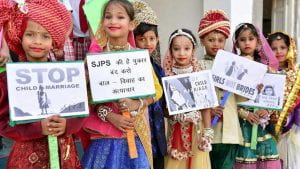Girls Not Brides-The Blossoming Freedom

In a rural village, a young girl full of dreams, was forced into an early marriage due to her family’s belief that it would secure a better future. Her education was cut short, limiting her potential to contribute to society. As the village’s literacy rate remained low, so did their GDP per capita reflecting the country economic situation. The cycle of poverty seemed unbreakable. Child marriage perpetuated the cycle, as girls were denied the opportunity to receive an education and develop valuable skills.
We planned to embed the world-wide best practice to fight this behavior and limit its exposure. The starting step is to recognize the importance of education and empowerment. Our role is to promote challenging the practice of child marriage, advocating for girls’ rights and investing in their education. Moreover, our duty is to provide life skills training and empowerment programs for girls at the age of 15 years. Other strategies should not be limited to the awareness and advocacy but to be extended to community engagement.
We have realized that after implementing the strategies, the literacy rate had increased, unlocking the potential of both girls and boys. As education flourished, so did the village’s GDP per capita. The correlation between breaking the chains of child marriage, education, and economic prosperity became evident.
The practice will become a model for progress, inspiring neighboring communities to follow suit. Child marriage gradually diminished, and more children, especially girls, were given the chance to pursue education and contribute to their society.
Through their determination and understanding, the village shattered the chains of child marriage, enabling a brighter future for generations to come. The investment in education proved to be the key to breaking the cycle of poverty. The correlation between ending child marriage, increasing literacy rates, and boosting GDP per capita was a powerful reminder of the transformative power of education and gender equality.

Refer to Graph I:
The percentage trend of women married or in union before age 15 has been gradually declining in many regions, although the pace of progress varies. The exact trends may vary from country to country and even within regions.
the global prevalence of child marriage has declined in recent years. The proportion of women aged 20-24 who were married or in union before age 15 dropped from 12% in 1995 to 6% in 2020. This indicates progress in efforts to reduce child marriage globally.
Some countries have shown significant declines in child marriage rates. For example, in South Asia, where child marriage rates have historically been high, countries like Bangladesh and Nepal have seen substantial reductions in child marriage prevalence over the past decade. In Sub-Saharan Africa, progress has also been observed in countries like Ethiopia, Rwanda, and Malawi.
However, it’s important to note that despite the overall decline, child marriage remains a significant issue in many regions, and there are still areas where progress has been slow or stagnant. Continued efforts and targeted interventions are necessary to further accelerate the decline in child marriage rates and achieve the goal of eliminating child marriage by 2030, as outlined in the Sustainable Development Goals.
Refer to Graph IV:
It’s important to note that child marriage can occur in different regions and countries other than subsharan Africa and South Asia. What’s crucial here is to direct the efforts to combat child marriage that should be tailored to address the specific cultural, social, and economic factors that contribute to the practice in each region.
It’s important to note that child marriage rates can change over time, and more recent data should be consulted for the most accurate information. Here are some countries that have historically had high child marriage rates:
1.Niger: Niger has one of the highest child marriage rates globally. According to UNICEF, about 76% of women aged 20-24 were married before the age of 18, and approximately 28% were married before the age of 15.
2.Chad: In Chad, child marriage rates are also significant. Around 68% of women aged 20-24 were married before the age of 18, and approximately 17% were married before the age of 15.
3.Bangladesh: Bangladesh has one of the highest child marriage rates in South Asia. Approximately 59% of women aged 20-24 were married before the age of 18, and around 22% were married before the age of 15.
4.Central African Republic: In the Central African Republic, child marriage rates are high, with about 52% of women aged 20-24 married before the age of 18, and around 17% married before the age of 15.
5.Mali: Mali also has a significant child marriage prevalence. Approximately 52% of women aged 20-24 were married before the age of 18, and around 16% were married before the age of 15.
6.South Sudan: In South Sudan, child marriage rates are high, with approximately 52% of women aged 20-24 married before the age of 18, and around 14% married before the age of 15.
It’s important to note that child marriage is not limited to these countries, and it occurs in various regions worldwide. Efforts are being made globally to address this issue and reduce child marriage rates through legislative measures, education programs, and community engagement.
Refer to Graph II & III:
It’s important to understand that the correlations can vary across different countries and regions. Cultural and social factors, as well as specific policy interventions, can also influence the relationship between child marriage and these indicators. Additionally, other factors, such as social norms, legal frameworks, and access to healthcare, also play significant roles in determining child marriage rates.
Efforts to address child marriage often focus on promoting education, economic opportunities, and gender equality. By improving literacy rates and fostering economic growth, societies can contribute to reducing child marriage rates and ensuring the well-being and empowerment of young girls.
The correlation between child marriage and GDP per capita as well as literacy rate can provide insights into the relationship between these factors. It’s important to note that correlation does not imply causation, but examining the association can shed light on potential patterns. Here is a general overview:
1.GDP per capita: There is evidence to suggest that there is an inverse correlation between child marriage and GDP per capita. Higher GDP per capita generally corresponds to lower child marriage rates. As countries experience economic development and improved living conditions, families may have greater resources and opportunities, leading to a decrease in child marriage rates. Economic empowerment can provide families with more choices, reduce poverty-driven motivations for child marriage, and increase access to education.
2.Literacy rate: There is a strong correlation between child marriage and literacy rate. Higher literacy rates are generally associated with lower child marriage rates. Education plays a crucial role in empowering individuals, particularly girls, by increasing their awareness of their rights and options. When girls have access to education and are encouraged to complete their schooling, they are more likely to delay marriage and pursue their personal and professional aspirations.
Efforts & Actions – till 2030
Efforts to eliminate child marriage have been ongoing at various levels, including international organizations, governments, non-governmental organizations (NGOs), and grassroots initiatives. While complete eradication of child marriage is a complex and long-term goal, significant progress has been made, and various strategies are being implemented to address the issue. Here are some key efforts:
1.International Conventions and Declarations: International conventions, such as the United Nations Convention on the Rights of the Child and the Convention on the Elimination of All Forms of Discrimination Against Women, highlight the importance of addressing child marriage and protecting the rights of children and women.
2.National Legislation: Many countries have enacted laws to raise the minimum age of marriage, strengthen child protection laws, and provide legal frameworks for combating child marriage. However, enforcement of these laws remains a challenge in some regions.
3.Awareness and Advocacy: Organizations and activists are working to raise awareness about the negative impact of child marriage on individuals and communities. They engage in advocacy efforts to mobilize support, change social norms, and promote gender equality and girls’ education.
4.Girls’ Education and Empowerment: Education is a crucial factor in preventing child marriage. Efforts are being made to improve access to quality education for girls, enhance school retention rates, and provide life skills training and empowerment programs.
5.Community Engagement: Engaging with communities, religious leaders, and local influencers is vital to address the root causes of child marriage. By promoting dialogue and community-led initiatives, it becomes possible to challenge traditional norms and beliefs that perpetuate child marriage.
6.Economic Empowerment: Programs that promote economic opportunities for girls and their families can contribute to reducing the economic drivers of child marriage. This includes vocational training, entrepreneurship support, and income-generating activities.
As for when child marriage is expected to be eliminated, it is challenging to provide a specific timeline. However, there is a global commitment to ending child marriage under the Sustainable Development Goals (SDGs), specifically Target 5.3, which aims to eliminate child, early, and forced marriage by 2030. Achieving this goal requires sustained efforts, collaboration, and continued commitment from all stakeholders involved.